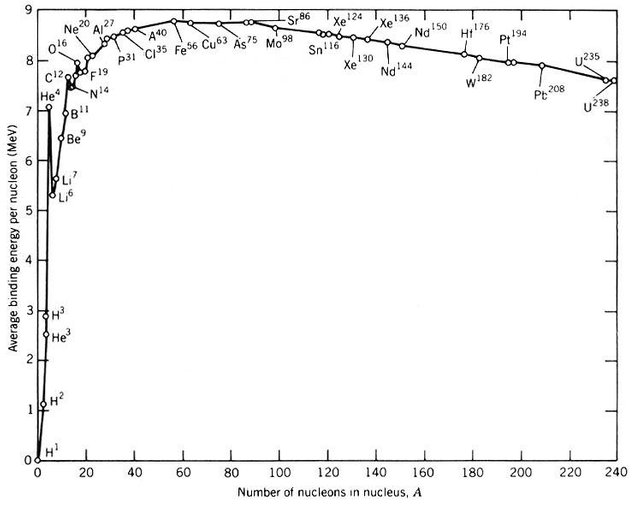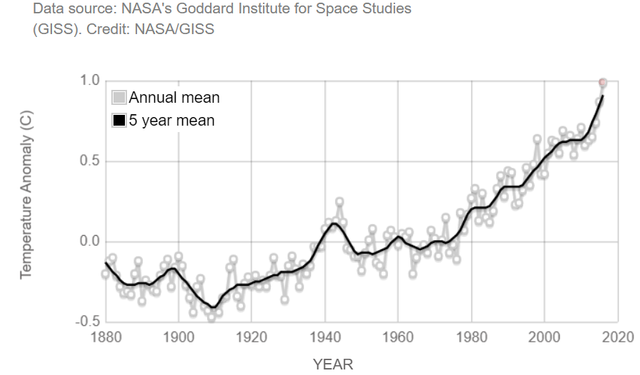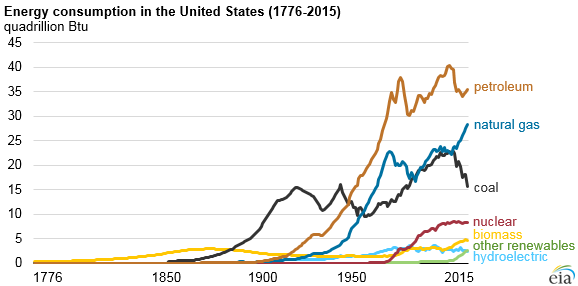Science Series about Fusion: Part 1- Introduction to Fusion
Hello fellow Steemitonians and welcome to my first installment in the Science series where I will go deep into the science of various physics-related topics. The first topic I will cover is fusion, more specifically fusion power. This topic will be split up into four parts and today I will try to introduce the basic concepts behind fusion so we have some tools at our disposal for further digging into this topic.
To understand fusion we must first understand nuclear reactions which transform one element into another. We have all heard about fission. It is a reaction where a heavy nucleus breaks apart and forms 2 smaller nuclei and possibly fragments like neutrons, protons or electrons. We harness the power of fission in nuclear reactors which are widespread across the world by capturing the heat that is produced during the fission reaction. A typical fission reaction that is used in reactors is:

Here a neutron hits a Uranium nucleus which makes it unstable and causes it to split apart into Barium and Krypton. Additionaly 3 neutrons are released which cause further fission in the reactor in a cascade. This is how fission reactors work.
In all nuclear reactions the energy that is released is equal to the difference between ALL the final masses and ALL initial masses times the speed of light squared:

This means that for any process to be efficient in producing energy, masses of the elements after the reaction must be smaller then the masses before the reaction.
Typicaly in elements with larger nuclei (heavier elements), fission will occur while in elements with lighter nuclei this process will not occur as it is inefficient to divide a small nuclei even further. In fact it is much more efficient to clump smaller nuclei further together - this is what we call fusion!
In Figure 1 we can see the binding energy per nucleon of the nucleus for all known elements. The higher the binding energy per nucleon the higher the stability of an element. To deduce if fission or fusion is efficient for a particular element we must look at the trend of the line. If the binding energy of elements heavier than the considered element is higher, fusion is efficient because a nucleus created from a given element will be more tightly bound together - more stable. And vice versa. If the binding energy of a lighter nucleus is higher then that of a given nucleus this nucleus is likely to break apart.

Figure 1: Binding energy per nucleus of all known elements. The process of fusion is relevent when the line is rising and fission is relevent when it is falling. The line is neither rising not falling at element Fe - iron. This is the most stable element in the universe. Taken from [1].
To put it more simply if the line is rising at a given element it is efficient for that element to fuse - fusion. If it is falling it is efficient to break apart - fission. The steepness of the line also indicates the efficiency of a process. The steeper the line the easier it is to trigger the process. We see that the line is steepest at the lightest elements. This means it is easiest to fuse the lightest elements which are hydrogen isotopes. In fact the first reactors will fuse tritium and deuterium, which are isotopes of hydrogen. I will be talking about how we actually fuse these elements in the next installment of this series on fusion.
Ever since the start of the last industrial revolution that saw its birth with the propagation of coal as a power source, the need for a sustainable power source has grown. The first effect of pollution on our planet, and more specifically our climate, has been scientifically documented in the 19th century [2]. But not much attention has been devoted to this subject for another century. Only in the late 20th century scientists have achieved worldwide consesus that global warming as seen in the rise in global average temperature over the years is the consequence of pollution induced by human activities.

Figure 2: The clear rising trend of average global temperature, that seems to be speeding up in recent decades. Taken from [3].
One of the main polluters in the world is the energy production sector. In Figure 3 we can see how this energy production is distributed between different energy sources in the USA. We see that eventhough renewable sources and nuclear energy are on the rise they have not been able to keep up with the exponential growth of the worlds population. This means that eventhough sources like oil and coal damage the environment we have no other option but to use them without an alternative.

Figure 3: The distribution of different sources of energy production in the USA. Taken from [4].
But you might think: "What about nuclear power? That is pretty cool!" Well unfortunatelly eventhough nuclear power produces vast amounts of power its implementation is difficult and hazardous. The nuclear fuel is hard to obtain and difficult to store. And also, more importantly, the side products of nuclear power are highly radiocative, which make them unsustainable in the long term. Here is where I present to you the energy source of the future - fusion.
As stated before the fuel for the first fusion reactors will be hydrogen or some isotopical form. We are lucky in this regard, because hydrogen is the most common element in the universe and can be easily obtainable through catalysis of water. Thats right, everyday, plain and simple water. It can be salty or not. It does not matter. This is already a big plus for fusion as a power source. A non-toxic and readily available fuel!
As I will show in my next post not only is the fuel completely benign, the final products of the fusion reaction that will take place in fusion reactors are a neutron and helium. Already air consists of a few percent of helium which clearly indicates that helium will not be an issue when it comes to fusion as a power source. The neutron will be stopped in the reactor and its energy converted to electricity through heat. This means the neutron will not escape the reactor and is as such also a non-issue.
So what does this mean. In short. Fusion reaction as a power source is completely clean and its effect on the environment is zero! Also because the fuel is so common in the universe there is enough fusion fuel to power our civilization for millions of years to come. Literally!
This is my first part of my science series on fusion. I hope I convinced you that fusion is not only important but also neccessary as a power source for our ever-growing civilization. I also hope I have intrigued you enough that you will be waiting on thenext part which I will publish sometime next week. In my next part I will be talking about the technological hurdles that prevent us from utilizing fusion power right now and I will also show how far we have come in this important field.
If you like the content please upvote and follow me for future content. For more information on me or this series you can check the announcement of this series. If you want to know morea about me you can check my introduction post.
Images are linked to their sources in their description and references are stated within the text.
Big thanks to @steemstem for allowing me to use their tag, name and banner in the following series. SteemSTEM is a community driven project which seeks to promote well written/informative Science Technology Engineering and Mathematics postings on Steemit. For more information on the SteemSTEM project join their steemit.chat.
.png)

.png)


Thank you for this post ! It's well structured and it's obvious that you've put a lot of effort in it. Even though I'm not a physicist like yourself, I grasped your message in this article and I will follow you for more posts like this. I advice everyone else, who liked it to do so as well ! Cheers !
Thank you very much!
I disagree with that conclusion.
If I remember well the time where I studied this (please correct me if I am wrong), one of the problems of nuclear fusion is related to the fact that the powerplant facility may be highly contaminated due to the byproduct neutrons. They stay inside the reactor, as you said, but the reactor will be in turn highly contaminated.
There are always some environmental drawbacks... which is also true for renewable energies by the way.
Right now, in ITER, the materials that we are planning to use are Be and W. And as far as we know they are activated very little by neutronic bombardement. Be is a very light element so it is pretty obvious it cant be activated very efficiently and I found this article for W which states the activity of W inside a reactor decays in about 1 day. Which is a non-factor in my opinion.
The reactor will be contaminated with implanted T, which is radioactive (I will talk more about this next time). In ITER the maximum retained amount will be 700 g. That is not very much. Especially if you take into account the decay constant of T which is 12.3 years. Also T has a beta decay which means that most of the electrons will be completely stopped in the wall material.
So in summary. There is some very localized impacts on the environment. But in the grand scheme of things I think they are negligeble.
I agree with what you said (I have stopped following the fusion stuff more than 10 years ago and I will be therefore happy to read the next episode).
However, I would avoid saying that it has a zero impact on the environment. A zero impact does not exist, on the one hand, and such claims that are not entirely correct (even if the level of imprecision is small) may have huge consequence at the general audience level (things escalade quickly).
It is better to stay with the facts and let the people make their own conclusions.
(This is my opinion, let's be clear.)
I agree I should be more careful with my wording and I will be in the future. But is it really "correct" for the people to make their own conclusion. We as physicist have the responsibility of deciding what is important and what is not, because we are the guys who trully understand the problems and their weight. The general public does not.
But yes. Instead of zero impact I should have said negligeble impact. Obviously editing is not appropriate at this stage so I will be more careful in the future.
Thank you for your comment, by the way. It is much appreciated. :)
What I think (again, it is my opinion and only my opinion), we can help the general audience to conclude by bringing the, all the arguments. But we should not conclude for them. Maybe I am wrong, and of course your topic is much more sensible than mine with respect to the public (so that in short, it is difficult to say) ;)
I definitly respect your opinion. I am just not sure if I agree with you. As you said. The energy sector is a touchy subject in the public. I think people are more likely to jump to conclusions which are not correct, because they are not really familliar with the concept of "negligeble" as it is understood in science.
I guess it depends how deeply and calmly you have the time to explain (as it is sensible, staying calm may be hard :p)
Very informative. Why haven't I heard about this before? It seems like this information should be known to more people so we can become more aware.
To be honest, I dont really know. I just watched a movie today that you might like. It is a documentary named Let there be light! Look it up.
Thanks for letting me know. Will look into it...
Congratulations @maticpecovnik, this post is the third most rewarded post (based on pending payouts) in the last 12 hours written by a Dust account holder (accounts that hold between 0 and 0.01 Mega Vests). The total number of posts by Dust account holders during this period was 4794 and the total pending payments to posts in this category was $687.16. To see the full list of highest paid posts across all accounts categories, click here.
If you do not wish to receive these messages in future, please reply stop to this comment.
Nice post ! I'll be following this serie with great interest :)
Thank you very much. :)
Congratulations @maticpecovnik! You have completed some achievement on Steemit and have been rewarded with new badge(s) :
Click on any badge to view your own Board of Honor on SteemitBoard.
For more information about SteemitBoard, click here
If you no longer want to receive notifications, reply to this comment with the word
STOPZelo dobro napisan post. Najboljša strategija so dolgi znanstveni postovi. Srečno!
Hvala ti puno, brate! :)
Jel si iz srbije. Svuda moze naci srbina 😎
Thank you very much. It ia much appreciatet!
Congratulations @maticpecovnik! You have completed some achievement on Steemit and have been rewarded with new badge(s) :
Click on any badge to view your own Board of Honor on SteemitBoard.
For more information about SteemitBoard, click here
If you no longer want to receive notifications, reply to this comment with the word
STOPI'm definitely looking forward to the rest in this series. Welcome to @steemstem!
Thank you very much. I will try to make my oost even better next time. There is always some room for improvement.